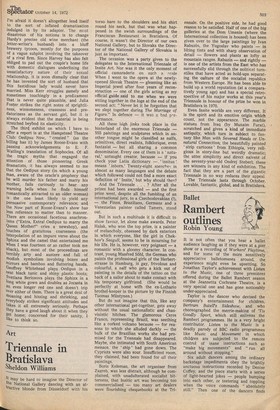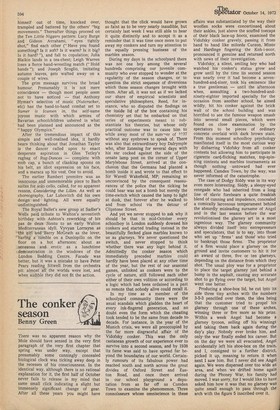Ballet
Rambert outlines
Robin Young
It is not often that you hear a ballet audience laughing as if they were at a pier show or a recording of Workers' Playtime, and for some of the more sensitively appreciative balletomanes around, the experience might even be upsetting. So Jonathan Taylor's achievement with Listen to the Music, One of three premieres offered during the Ballet Rambert season at the Jeannetta Cochrane Theatre, is a very special one and has gone noticeably under-appreciated.
Taylor is the dancer who devised the company's entertainment for children, Bertram Batell's Sideshow, and who choreographed the merrie-making of 'Tis Goodly Sport, which still enlivens the Rambert programmes. He is a very bright contributor. Listen to the Music is a deadly parody of BBC radio programmes like Music and Movement in which children are subjected to the remote control of inane instructions such as "make big movements" and "run all around without stopping."
Six adult dancers among the ordinary backstage impedimenta obey the brightly unctuous instructions recorded by Denise Coffey, and the piece starts with a series of light-hearted jokes — people bumping into each other, or teetering and toppling
when the voice commands absolutely still." Then one of the dancers finds himself out of time, knocked over, trampled and battered by the others' "big movements." Thereafter things proceed on the Ten Little Niggers pattern: Lucy Burge and Gideon Avrahami, "eyes tightly shut," find each other (" Have you found something? Is it soft? Is it warm? Is it big? Is it hard? "), and fall to copulation; Julia Blaikie lands in a tea-chest; Leigh Warren loses a fierce hand-wrestling match (" Hold hands "); and Joseph Scoglio, imitating autumn leaves, gets wafted away on a couple of wires.
The grim message survives the broad humour. Presumably it is not mere coincidence — though most people seem not to have noticed — that Anthony Hymas's selection of music (Nutcracker, etc) has the hand-to-hand combat set to Sumer is lcumen in, the self-same joyous music with which armies of Bavarian schoolchildren ushered in what had been planned and announced as the "happy Olympics."
After the tremendous impact of this simple and well-realised idea, it hardly bears thinking about that Jonathan Taylor is the dancer called upon to enact desperate aspiration in Glen Tetley's ragbag of Rag-Dances — complete with mob cap, a bunch of clanking spoons on his belt, an idiot expression on his face, and a maraca up his vest. One to avoid.
The earlier Rambert premiere was an innocuous and unmemorable piece to Bach suites for solo cello, called, for no apparent reason, Considering the Lilies. As well as choreography, Lar Lubovitch did •his own design and lighting. All were equally undistinguished.
The Royal Ballet's new group at Sadler's Wells paid tribute to Walton's seventieth birthday with Ashton's reworking of his pas de deux Siesta to an early Walton Mediterranean idyll. Vyvyan Lorrayne as ;"the girl and 'Barry McGrath as the lover, c"having a tinnble on a Dunlopillo on the floor on a hot afternoon: about as Isensuous and erotic as a lunchtime demonstration in the windows of the London Bedding Centre. Facade was better, but it was a mistake to have Peter Pears reading Sitwell from the orchestra pit: almost all the worlds were lost, and when audible they did not fit the action.















































 Previous page
Previous page